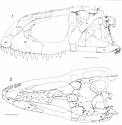Abelisauridae Dinosaur Classification
Homepage > Dinosaur Classification > Abelisauridae Classification
Abelisauridae is a clade of dinosaurs from the Cretaceous period that is documented in South America, Madagascar, and India, what used to be Gondwana. Abelisaurids are the best represented group of predatory dinosaurs from the Cretaceous deposits in both number of specimens and species diversity.
Abelisaurids underwent a significant evolutionary change during the Cretaceous Period in South America, becoming large carnivores.
The Abelisauridae clade was established originally by Bonaparte and Novas in 1985. They included Abelisaurus comahuensis from the Late Cretaceous Period. Abelisaurus was identified as a distinct taxon, apart from other theropods.
The list of abelisaurids increased with the addition of Carnotaurus sastrei (Bonaparte et al. 1990), Xenotarsosaurus bonapartei (Martinez et al., 1986), Indosaurus matleyi and Indosuchus raptorius.
 Diagnostic
characteristics of the Abelisauridae clade are concentrated in the skull
structure of the dinosaur. Their craniocaudally short and deep premaxilla;
dorsoventrally deep snout at the level of the narial openings; frontals
dorsoventrally thickened resulting in a dorsal bulking, paired horn-like
structures or a dome-like prominence.
Diagnostic
characteristics of the Abelisauridae clade are concentrated in the skull
structure of the dinosaur. Their craniocaudally short and deep premaxilla;
dorsoventrally deep snout at the level of the narial openings; frontals
dorsoventrally thickened resulting in a dorsal bulking, paired horn-like
structures or a dome-like prominence.
Abelisaurus seems to be related to the small theropod Noasaurus leali. Both of these taxa share maxillae with subvertical ascending rami and in the morphology of cervical vertebrae.